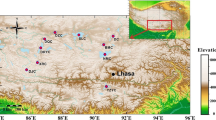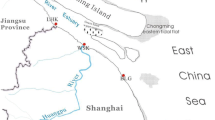Abstract
The abundance, distribution, and phylogenetic diversity of members of the Fe(III)-reducing family Geobacteraceae were studied along a gradient of metal contaminants in Lake Coeur d’Alene, Idaho. Partial 16S rRNA gene fragments were amplified by PCR using primers directed toward conserved regions of the gene within the family Geobacteraceae. Analysis of amplicons separated by denaturing gradient gel electrophoresis (DGGE) suggested within-site variation was as great as between-site variation. Amplicons were cloned and grouped by RFLP type and DGGE migration distance and representatives were sequenced. Grouping clones with 3% or less sequence dissimilarity, 15 distinct phylotypes were identified compared to 16 distinct DGGE bands. Only 1 phylotype was recovered from all sites. This clone, B14, is most closely related to Geobacter metallireducens and constituted a greater portion of the pristine community than of the contaminated communities. A second phylotype, Q2, predominated in the contaminated communities and was notably absent from the pristine libraries. Clone Q2 presents a high degree of sequence similarity to two Geobacter spp. previously isolated from this region of Lake Coeur d’Alene. Six phylotypes were unique to the contaminated sediments, whereas two were found only in the pristine sediments. Indices of diversity (Shannon and Simpson) were consistently higher when calculated with DGGE data than when clone library data were used. Most-probable-number PCR and real-time PCR suggested that the Geobacteraceae phylotypes were spread relatively evenly across all three sites along the gradient. Our data indicate that the Geobacteraceae are diverse and abundant in Lake Coeur d’Alene sediments, regardless of metals content. These results provide insight into the ability of dissimilatory Fe(III)-reducing bacteria to colonize habitats with elevated metal concentrations, and they have important implications for the management and remediation of metal-contaminated sites.
Similar content being viewed by others
References
Albrechtson H-J, DiChristina TJ (1994) Evidence for microbial iron reduction in a landfill leachate-polluted aquifer (Vejen, Denmark). Appl Environ Microbiol 60:3920–3925
Altschul SF, Gish W, Miller W, Myers EW, Lipman DJ (1990) Basic local alignment search tool. J Mol Biol 215:403–410
Anderson RT, Rooney-Varga JN, Gaw CV, Lovley DR (1998) Anaerobic benzene oxidation in the Fe(III) reduction zone of petroleum-contaminated aquifers. Environ Sci Technol 32:1222–1229
Boone DR, Liu Y, Zhao Z-J, Balkwill DL, Drake GR, Stevens TO, Aldrich HC (1995) Bacillus infernus sp. nov., an Fe(III)-and Mn(IV)-reducing anaerobe from the deep terrestrial subsurface. Int J Syst Bacterid 45:441–448
Buerge IJ, Hug SJ (1997) Kinetics and pH dependence of chromium(VI) reduction by iron(II). Environ Sci Technol 31:1426–1432
Caccavo Jr. F, Blakemore RP, Lovley DR (1992) A hydrogen-oxidizing, Fe(III)-reducing microorganism from the Great Bay Estuary, New Hampshire. Appl Environ Microbiol 58:3211–3216
Cannone JJ, Subramanian S, Schnare MN, Collett JR, D’Souza LM, Du Y, Feng B, Lin N, Madabusi LV, Muller KM, Pande N, Shang Z, Yu N, Gutell RR (2002) The comparative RNA web (CRW) site: An online database of comparative sequence and structure information for ribosomal, intron, and other RNAs. BMC Bio informatics 3:2
Chapelle FH, Lovley DR (1992) Competitive exclusion of sulfate reduction by Fe(III)-reducing bacteria: a mechanism for producing discrete zones of high-iron ground water. Ground Wat 30:29–36
Coates JD, Achenbach LA (2002) The biogeochemistry of aquifer systems. In: Hurst CJ, Crawford RL, Knudsen GR, Mclnerney MJ, Stetzenbach LD (Eds.) Manual of Environmental Microbiology, 2nd ed. ASM Press, Washington, DC
Coates JD, Ellis DJ, Gaw CV, Lovley DR (1999) Geothrix fermentans gen. nov., sp. nov., a novel Fe(III)-reducing bacterium from a hydrocarbon-contaminated aquifer. Int J Syst Bacteriol 49:1615–1622
Coates JD, Lonergan DJ, Lovley DR (1995) Desulfuromonas palmitatis sp. nov., a long-chain fatty acid-oxidizing Fe(III) reducer from marine sediments.Arch Microbiol 64:406–413
Cooper DC, Picardal F, Rivera J, Talbot C (2000) Zinc immobilization and magnetite formation via ferric oxide reduction by Shewanella putrefaciens 200. Environ Sci Technol 34:100–106
Cummings DE, Caccavo Jr. F, Fendorf S, Rosenzweig RF (1999) Arsenic mobilization by the dissimilatory Fe(III)-reducing bacterium Shewanella alga BrY. Environ Sci Technol 33:723–729
Cummings DE, March AW, Bostick B, Spring S, Caccavo F, Jr. Fendorf S, Rosenzweig RF (2000) Evidence for microbial Fe(III) reduction in anoxic, mining-impacted lake sediments (Lake Coeur d’Alene, Idaho). Appl Environ Microbiol 66:154–162
Cummings DE, Spring S, Caccavo F, Jr. Rosenzweig RF (1999) Ferribacterium limneticum, gen. nov., sp. nov., an Fe(III)-reducing microorganism isolated from mining-impacted freshwater lake sediments. Arch Microbiol 171:183–188
De Wever H, Cole JR, Fettig MR, Hogan DA, Tiedje JM (2000) Reductive dehalogenation of trichloroacetic acid by Trichlorobacter thiogenes gen. nov., sp. nov. Appl Environ Microbiol 66:2297–2301
Ellis MM (1940) Pollution of the Coeur d’Alene River and adjacent waters by mine wastes. Special Sci. Rep. No. 1, US Bureau of Fisheries, Washington, DC
Fendorf SE, Li GC (1996) Kinetics of chromate reduction by ferrous iron. Environ Sci Technol 30:1614–1617
Finneran KT, Anderson RT, Nevin KP, Lovley DR (2002) Bioremediation of uranium-contaminated aquifers with microbial U(VI) reduction. Soil Sed Contam 11:339–357
Fredrickson JK, Zachara JM, Kukkadapu RK, Gorby YA, Smith SC, Brown CF (2001) Biotransformation of Ni-substituted hydrous ferric oxide by an Fe(III)-reducing bacterium. Environ Sci Technol 35:703–712
Gibbs-Eggar Z, Jude B, Dominik J, Loizeau J-L, Oldfield F (1999) Possible evidence for dissimilatory bacterial magnetite dominating the magnetic properties of recent lake sediments. Earth Plan Sci Lett 168:1–6
Gorby YA, Lovley DR (1992) Enzymatic uranium precipitation. Environ Sci Technol 26:205–207
Hammer Ø, Harper DAT, Ryan PD (2001) PAST: Paleontological statistics software package for education and data analysis. Palaeontologia Electronica4. http://palaeo-elect->ronica.org/2001_2001/past/issue2001_2001.htm
Harrington JM, Fendorf SE, Rosenzweig RF (1998) Biotic generation of arsenic(III) in metal(loid)-contaminated freshwater lake sediments. Environ Sci Technol 32:2425–2430
Harrington JM, LaForce MJ, Rember WC, Fendorf SE, Rosenzweig RF (1998) Phase associations and mobilization of iron and trace elements in Coeur d’Alene Lake, Idaho. Environ Sci Technol 32:650–656
Holmes DE, Finneran KT, O’Neil RA, Lovley DR (2002) Enrichment of members of the family Geobacteraceae associated with stimulation of dissimilatory metal reduction in uranium-contaminated aquifer sediments. Appl Environ Microbiol 68:2300–2306
Horowitz AJ, Elrick KA, Robbins JA, Cook RB (1995) A summary of the effects of mining and related activities on the sediment-trace element geochemistry of Lake Coeur d’Alene, Idaho, USA. J Geochem Explor 52:135–144
James BD, Olsen GJ, Pace NR (1989) Phylogenetic comparative analysis of RNA secondary structure. Methods Enzymol 180:227–239
Kazumi J, Häggblom MM, Young LY (1995) Degradation of monochlorinated and nonchlorinated aromatic compounds under iron-reducing conditions. Appl Environ Microbiol 61:4069–4073
Kennedy LG, Everett JW, Ware KJ, Parsons R, Green V (1998) Iron and sulfur mineral analysis methods for natural attenuation assessments. Bioremed J 2:259–276
Kim S, Picardal FW (1999) Enhanced anaerobic biotransformation of carbon tetrachloride in the presence of reduced iron oxides. Environ Toxicol Chem 18:2142–2150
Kopczynski ED, Bateson AM, Ward DM (1994) Recognition of chimeric small-subunit ribosomal DNAs composed of genes from uncultivated microorganisms. Appl Environ Microbiol 60:746–748
Lerman LS, Fischer SG, Hurley I, Silverstein K, Lumelsky N (1984) Sequence-determined DNA separations. Annu Rev Biophys Bioeng 13:399–423
Lloyd JR, Chesnes J, Glasauer S, Bunker DJ, Livens FR, Lovley DR (2002) Reduction of actinides and fission products by Fe(III)-reducing bacteria. Geomicrobiol J 19:103–120
Lonergan DJ, Jenter H, Coates JD, Phillips EJP, Schmidt TM, Lovley DR (1996) Phylogenetic analysis of dissimilatory Fe(III)-reducing bacteria. J Bacteriol 178:2402–2408
Lovley DR (1995) Bioremediation of organic and metal contaminants with dissimilatory metal reduction. J Ind Microbiol 14:85–93
Lovley DR, Phillips EJP (1986) Organic matter mineralization with reduction of ferric iron in anaerobic sediments. Appl Environ Microbiol 51:683–689
Lovley DR, Phillips EJP (1992) Bioremediation of uranium contamination with enzymatic uranium reduction. Environ Sci Technol 26:2228–2234
Lovley DR, Phillips EJP, Lonergan DJ (1991) Enzymatic versus nonenzymatic mechanisms for Fe(III) reduction in aquatic sediments. Environ Sci Technol 25:1062–1067
Lowe KL, DiChristina TJ, Roychoudhury AN, Van Cappellen P (2000) Microbiological and geochemical characterization of microbial Fe(III) reduction in salt marsh sediments. Geomicrobiol J 17:163–178
Maidak BL, Cole JR, Charles J, Parker T, Garrity GM, Larsen N, Li B, Lilburn TG, McCaughey MJ, Olsen GJ, Overbeek R, Pramanik S, Schmidt TM, Tiedje JM, Woese CR (1999) A new version of the RDP (Ribosomal Database Project). Nucleic Acids Res 27:171–173
Marchesi JR, Weightman AJ, Cragg BA, Parkes RJ, Fry JC (2001) Methanogen and bacterial diversity and distribution in deep gas hydrate sediments from the Cascadia Margin as revealed by 16S rRNA molecular analysis. FEMS Microbiol Ecol 34:221–228
Mudroch A, MacKnight S (1994) Handbook of Techniques for Aquatic Sediment Sampling. Lewis Publishers, Boca Raton, FL
Muyzer G, DeWaal EC, Uitterlinden AG (1993) Profiling of complex microbial populations by denaturing gradient gel electrophoresis analysis of polymerase chain reaction-amplified genes coding for 16S rRNA. Appl Environ Microbiol 59:695–700
Niggemyer AM, Spring S, Stackebrandt E, Rosenzweig RF (2001) Isolation and characterization of a novel As(V)-reducing bacterium: implications for arsenic mobilization and the genus Desulfitobacterium. Appl Environ Microbiol 67:5568–5580
Picard C, Ponsonnet C, Paget E, Nesme X, Simonet P (1992) Detection and enumeration of bacteria in soil by direct DNA extraction and polymerase chain reaction. Appl Environ Microbiol 58:2717–2722
Picardal F, Arnold RG, Huey BB (1995) Effects of electron donor and acceptor conditions on reductive dehalogenation of tetrachloromefhane by Shewanella putrefaciens 200. Appl Environ Microbiol 61:8–12
Roling WF, van Breukelen BM, Braster M, Lin B, van Verseveld HW (2001) Relationships between microbial community structure and hydrochemistry in a landfill leachate-polluted aquifer. Appl Environ Microbiol 67:4619–4629
Rooney-Varga JN, Anderson RT, Fraga JL, Ringelberg D, Lovley DR (1999) Microbial communities associated with anaerobic benzene degradation in a petroleum-contaminated aquifer. Appl Environ Microbiol 65:3056–3063
Snoeyenbos-West OL, Nevin KP, Anderson RT, Lovley DR (2000) Enrichment of Geobacter species in response to stimulation of Fe(III) reduction in sandy aquifer sediments. Microb Ecol 39:153–167
Snoeyenbos-West OL, Van Praagh CG, Lovley DR, De Wever H, Cole JR, Fettig MR, Hogan DA, Tiedje JM (2001) Trichlorobacter thiogenes should be renamed as a Geobacter species: Letter to the editor and authors’ reply. Appl Environ Microbiol 67:1020–1021
Speksnijder AGCL, Kowalchuk GA, De Jong S, Kline E, Stephen JR, Laanbroek HJ (2001) Micro variation artifacts introduced by PCR and cloning of closely related 16S rRNA gene sequences. Appl Environ Microbiol 67:469–472
Stein LY, La Due MT, Grundl TJ, Nealson KH (2001) Bacterial and archaeal populations associated with freshwater ferromanganous micronodules and sediments. Environ Microbiol 3:10–18
Stookey LL (1970) Ferrozine: a new spectrophotometric reagent for iron. Anal Chem 42:779–781
Stults JR, Snoeyenbos-West OL, Methe BA, Lovley DR, Chandler DP (2001) Application of the 5′ fluorogenic exonuclease assay (TaqMan) for quantitative ribosomal DNA and rRNA analysis in sediments. Appl Environ Microbiol 67:2781–2789
Swofford DL (1998) PAUP* Phylogenetic Analysis Using Parsimony (*and other methods) Version 4, 4th ed. Sinauer Associates, Sunderland, MA
Taillefert M, Bono AB, Luther GW (2000) Reactivity of freshly formed Fe(III) in synthetic solutions and (pore)waters: Voltammetric evidence of an aging process. Environ Sci Technol 34:2169–2177
Van de Peer Y, De Wachter Y (1994) TREECON for Windows: a software package for the construction and drawing of phylogenetic trees for the Microsoft Windows environment. Comp Applic Biosci 10:569–570
Woods PF (1989) Hypolimnetic concentrations of dissolved oxygen, nutrients, and trace elements in Coeur d’Alene Lake, Idaho. USGS Water-Resources Investig Rep 89-4032
Zachara JM, Fredrickson JK, Smith SC, Gassman PL (2001) Solubilization of Fe(III) oxide-bound trace metals by a dissimilatory Fe(III) reducing bacterium. Geochim Cosmochim Acta 65:75–93
Zar JH (1996) Biostatistical Analysis, 3rd ed. Prentice Hall Upper Saddle, River, NJ
Zhou J, Liu S, Xia B, Zhang C, Palumbo AV, Phelps TJ (2001) Molecular characterization and diversity of thermophilic iron-reducing enrichment cultures from deep subsurface environments. J Appl Microbiol 90:96–105
Author information
Authors and Affiliations
Corresponding author
Additional information
Online publication: 4 July 2003
Rights and permissions
About this article
Cite this article
Cummings, D.E., Snoeyenbos-West, O.L., Newby, D.T. et al. Diversity of geobacteraceae species inhabiting metal-polluted freshwater lake sediments ascertained by 16S rDNA analyses. Microb Ecol 46, 257–269 (2003). https://doi.org/10.1007/s00248-005-8002-3
Received:
Accepted:
Issue Date:
DOI: https://doi.org/10.1007/s00248-005-8002-3




